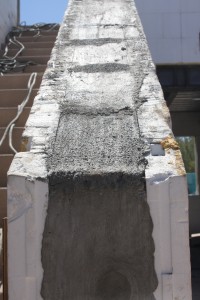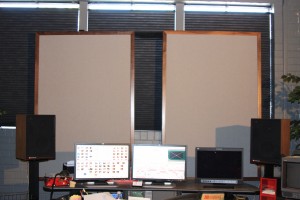What Is Soundproofing?
Soundproofing a room means that people want to either keep sound energy from entering a room or keep the sound made in the room, inside the room where it belongs. Most of the time both are desired. Each approach requires different science to solve and before you start any project you have to keep these two sciences in mind. So first lets define each area of barrier and sound absorption technology before explaining how to approach the solution.
Barrier Technology
To keep outside sound energy or any sound that is generated from outside your room, outside where it belongs, you need to use barrier technology. You need to create a barrier between the sound on the outside and your room. Barrier technology is designed to reflect sound energy back to the source or the direction in which it came by creating a barrier or sound blocking structure between you or the room and the outside sound source.
Sound Absorption Technology
To manage sound that occurs within our rooms, you need to use sound absorption technologies. You must absorb the excess energy within your room, so that it does does not create issues within the room. You must manage the excess energy through sound absorption, so that the sound energy does not “bleed” into the rooms that adjoin our sound room. Everyone has had this issue.
Step # 1 Define The Noise Issue
You must first define what noise issues that you need your barrier technology to stop. What is the noise level you need to address that comes from sources outside your room? Is it traffic noise, people talking, manufacturing sounds? One must put a number to this noise. One can use a Radio Shack SPL meter (60 USD) or as they call it decibel meter. Go out in the morning, afternoon, and evening and take some readings over a 15 minute time span. Takes highs and lows and average, say 10 or so readings. Measure it over a one week time frame. Include hours of most noise and then measure the quietest times. Now, you must define what you have measured.
Step # 2 Measure The Noise Issues
What kind of noise is it? What part of the frequency spectrum does the most noise occur at? What part of the frequency spectrum does the smallest sound pressure level occur at? Is it low frequency, middle frequency, or high frequency noise we are dealing with? This is a little more difficult than using a SPL meter. One will need to take frequency response readings to match the pressure readings. This is best left to the professionals unless one is familiar with the process. All of this information is required in order to build the proper barrier technology to minimize your noise issues. If you have low frequency issues from garbage trucks going by, one must build a different barrier than if you are trying to keep the phone voice from the next office from disturbing your lunch.
Step # 3 Define Your Room’s Purpose
Defining what your room will be used for is critical. If you are recording within this room, we need a certain sound pressure level of quiet. Are we recording vocals or bands. Each has different “quiet” requirements. If you are using your room as an office, you need to be concerned with middle and higher frequencies from entering, so that vocal mid range frequencies will not be impacted. Intended use is critical for defining how much we have to spend with barrier technology to protect your room’s sound environment and lower the noise floor to acceptable minimums for the room’s use.
Step # 4 Barrier Build Materials
Once you have all your data about the outside created noise and have defined your intended room usage, you can choose the materials and wall construction method to address the level of frequencies of the noise issues we have coming in from the outside. If they are low frequency issues, it would be advisable to find a new location. It is usually more cost effective to find a new location than trying to stop low frequency energy.
Low frequency energy take thick barriers to isolate you from the long low frequency wavelengths. The more mass we use and use it we must, for low frequency energy isolation, the more our costs go up. Considering the cost of isolation from these long and powerful wavelengths, it is very difficult to build the proper wall to keep this energy at bay. Every low frequency Db costs lots of mass and money to isolate oneself from. It would be better cost wise to consider another location if you have to deal with too much low frequency energy in your room.
Step # 5 Inside Our Room
If you are in an office environment and need to absorb excess voice and office equipment noise, you can use standard sound absorptive technologies. Sound absorbing foam can be used along with sound absorbing ceiling tiles. Drapes can cover office windows and special builds can be created to control and mange equipment noise. Even a couch can be an absorber.
Recording Studio
If you are recording a band within your room, you will need to mange and control the full frequency range of sounds. Drums produce low frequency energy and that energy must be managed, so that the microphone picks up and thus records the drum sound the engineer wants. Absorbing excess drum sound means less room sound or more depending on what the producer thinks the drum part calls for. Excess low frequency energy within a recording studio is usually unwanted and specially designed and positioned low frequency absorbers must be used.
Vocal Rooms
Our vocal rooms are usually located within our studio walls. There is a reason for this. Vocal rooms are a room within a room. This is an ideal method for achieving sound isolation. They are full of sound absorption and diffusion technologies to manage the sound energy within the vocal room itself. The studio provides the barrier or shell to keep outside noise outside. Usually a balance of sound absorption and diffusion technologies are used inside a vocal room.
Must Follow Steps
How to sound proof a room must be approached in a series of steps that you must follow in the order listed above if success is to be achieved both inside and outside the room. You must employ barrier technology to keep unwanted noise out of Your room and then you must use sound absorption technology to soak up excess sound energy that is generated within Your rooms from sound sources such as instruments and vocals. One must measure how large of a noise problem, both inside and outside your room, and construct the proper barrier to mange this unwanted energy effectively. Once you have your numbers, you can design and build the proper structure that will accomplish your acoustical objectives without draining your financial objects.







